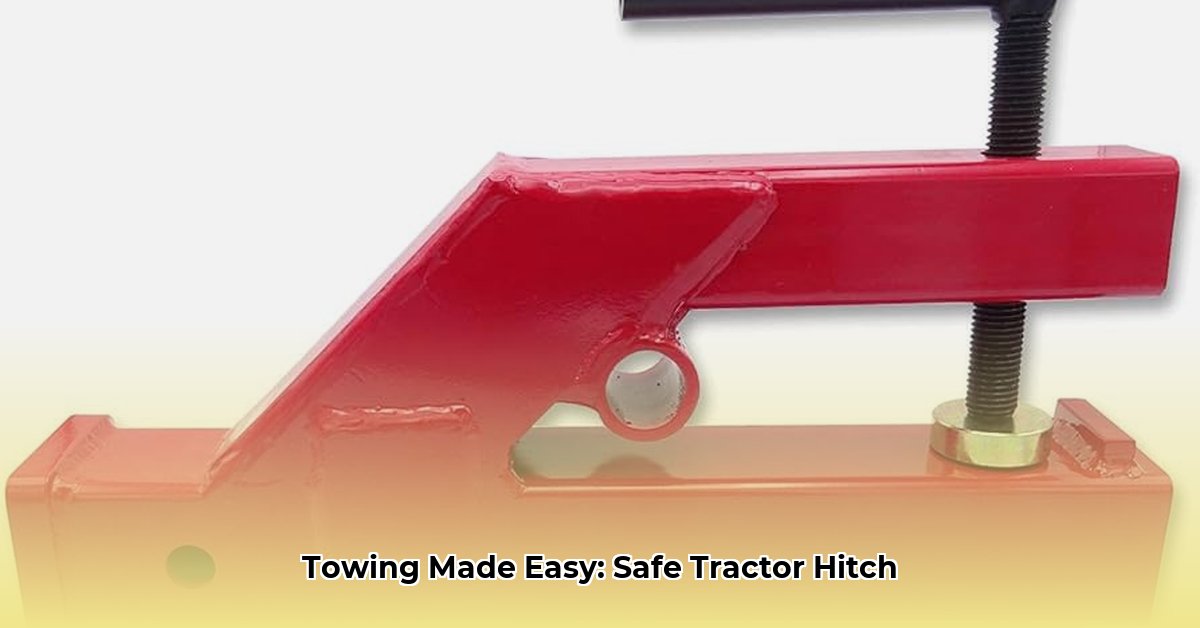
Choosing Your Tractor's Clamp-On Hitch: Matching the Hitch to the Job
Selecting the right clamp-on hitch is paramount for safe and efficient towing. Just as you wouldn't use a wheelbarrow to move a construction-sized load, choosing a hitch with insufficient weight capacity is risky. Begin by honestly assessing the weight of trailers you'll regularly tow. Will you move small loads of garden supplies or several tons of hay bales? The hitch's weight capacity must significantly exceed your anticipated maximum weight, ideally with a generous safety margin. Never exceed the manufacturer's specified maximum towing weight. This is non-negotiable. For more detailed information on hitch types, see our Hitch Guide.
Next, ensure compatibility with your tractor's bucket. A loose fit invites disaster. Look for a tight, secure connection. Robust clamping mechanisms are essential for withstanding heavy loads and rough terrain. Prioritize solid, reliable metal construction over flimsy materials; this investment safeguards your safety and equipment. Read specifications carefully; vague descriptions are unacceptable. You must have confidence in its capabilities. Finally, while price is a factor, it should not overshadow safety and reliability. A longer-lasting, safer hitch saves money and prevents injury in the long run.
Installing Your Tractor Clamp-On Hitch: A Step-by-Step Guide
Before installation, meticulously read the manufacturer's instructions. These instructions are specific to the hitch and provide essential guidance. Always follow general safety precautions as well. This is a general guideline; consult your hitch's specific instructions.
Step 1: Bucket Preparation: Clean the lip of your tractor bucket thoroughly. Remove all dirt, debris, and mud for a secure connection. A clean surface ensures proper contact.
Step 2: Hitch Alignment: Carefully position the hitch against the bucket lip, ensuring perfect alignment and a snug fit. A misaligned hitch is dangerous.
Step 3: Secure Clamping: Tighten the clamps firmly and evenly. Don't rush; uneven clamping stresses the hitch and increases failure risk. Use appropriate tools; power tools should only be used if specified in the instructions.
Step 4: Stability Check: Gently tug on the hitch to confirm stability. If there's any looseness, readjust the clamps immediately. A wobbly hitch is an unsafe hitch.
Step 5: Trailer Connection: Connect the trailer, following its instructions. Double-check all connections. A loose trailer is a serious hazard.
Safe Operation: Keeping Yourself and Your Equipment Safe
Responsible hitch use is as vital as correct installation. Here are critical safety tips.
Weight Limits: Absolutely Essential: Never exceed the hitch's or tractor's weight limits. Overloading is the primary cause of equipment failure and accidents. Maintain a significant safety margin.
Terrain Awareness: Be mindful of the terrain. Avoid uneven ground or steep inclines. Rough terrain increases wear and tear and accident risk.
Regular Inspections: Regularly inspect clamps, connections, and the hitch for wear, damage, or looseness. Small issues can escalate into major problems.
Proper Loading: Evenly distribute weight on the trailer and secure the load. Shifting loads are exceptionally dangerous. A well-balanced load dramatically improves safety.
Troubleshooting Common Hitch Problems
Even with careful practices, problems can occur. Here are some common issues and solutions.
Loose Clamps: This often results from uneven tightening or vibration. Retighten the clamps, ensuring even pressure.
Bucket Compatibility Issues: This usually arises from incorrect hitch selection. Always verify compatibility before purchase.
Excessive Wear: Worn components require immediate replacement. Continuing use is extremely dangerous.
The Market for Tractor Clamp-On Hitches: A Quick Overview
Clamp-on hitches are versatile, but limitations exist. Many models have lower towing capacities than other hitch types. Therefore, use them only for smaller trailers and loads within their rated capacity. Safety certifications vary; some may lack certification entirely. Always check for safety certifications before purchasing.
Comparison Table (Illustrative Example)
This table provides hypothetical examples; specific models and pricing vary. Always verify with the manufacturer.
| Model | Towing Capacity (lbs) | Clamping Mechanism | Approximate Price (USD) | Safety Certification |
|---|---|---|---|---|
| Titan Hitch A | 1100 | Bolt-on | $150 - $200 | None |
| Acme Hitch B | 1500 | Clamp-on | $200 - $250 | None |
| Strong Hitch C | 2000 | Heavy-Duty Clamp-on | $300 - $400 | Pending |
Important Note: Always consult the manufacturer’s specifications for the most accurate information.
Remember, safety is paramount. Careful selection and responsible operation are crucial for safe and efficient towing.